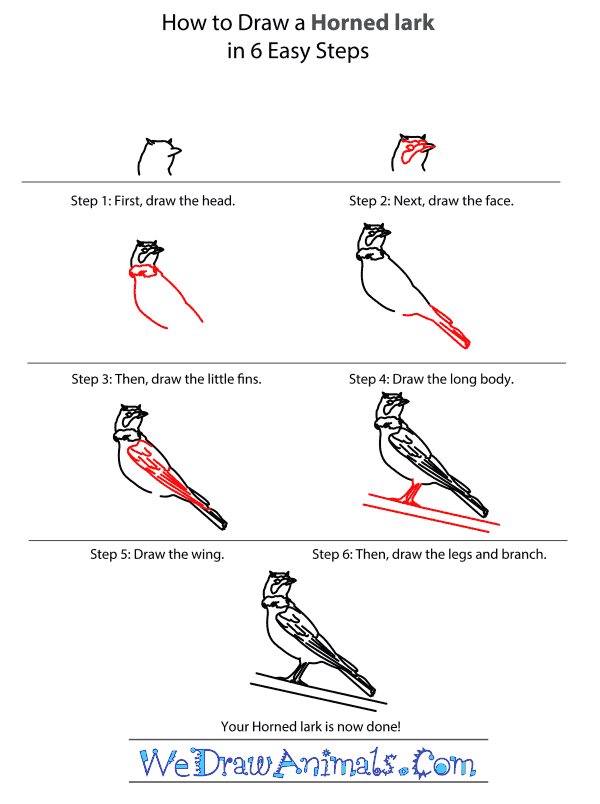In this quick tutorial you'll learn how to draw a Horned Lark in 6 easy steps - great for kids and novice artists.
The images above represent how your finished drawing is going to look and the steps involved.
Below are the individual steps - you can click on each one for a High Resolution printable PDF version.
At the bottom you can read some interesting facts about the Horned Lark.
Make sure you also check out any of the hundreds of drawing tutorials grouped by category.
How to Draw a Horned Lark - Step-by-Step Tutorial
Step 1: To start off, you'll draw the head. Draw a long half circle, and then add a nose and little indents for horns
Step 2: Next, draw the face. It's a little complicated, but make sure to draw the eyes and then make an attempt to draw the detail to the face
Step 3: Next you'll draw the body. The neck is a small, rough oval, and then the rest of the body slants diagonally, long and narrow.
Step 4: To draw the tail, draw the outline of it and then add lines to create feather
Step 5: Draw the wing. Like the tail, draw the outline of the wing and then add lines and curves to make feathers
Step 6: Finally, draw lines to make the legs, and then a small tree branch underneath.
Interesting Facts about the Horned Lark
The horned lark is a songbird that lives in the United States, Canada, and Mexico. They are ground foragers that eat seeds and insects. Horned larks are social birds that live in flocks. The horned lark prefers open country or grassland habitats. It is brown in color with a yellow face. It also has a black mask and tiny black horn-like feathers. The horned lark grows from 6.3 to 7.9 inches in length, has a wingspan from 11.8 to 13.4 inches, and weighs from 1 to 1.7 ounces.
Did you know?
- Female horned larks build their nests on the ground.
- There is an estimated global breeding population of 120 million horned larks.
- The horned lark is not threatened.
- The longest lifespan on record was 7 years, 11 months.
- The horned lark is also known as a shore lark.
- The horned lark has a resident to short-distance migration. They travel south in the winter months from the northern parts of North America to the United States.
Lesson plan note: Play bird sounds for your children to listen to. You can purchase recordings or search the internet for bird songs. Then, have each child try to duplicate the sounds that they hear. Notice how different species have differing vocalizations. Discuss the importance of the bird song.







